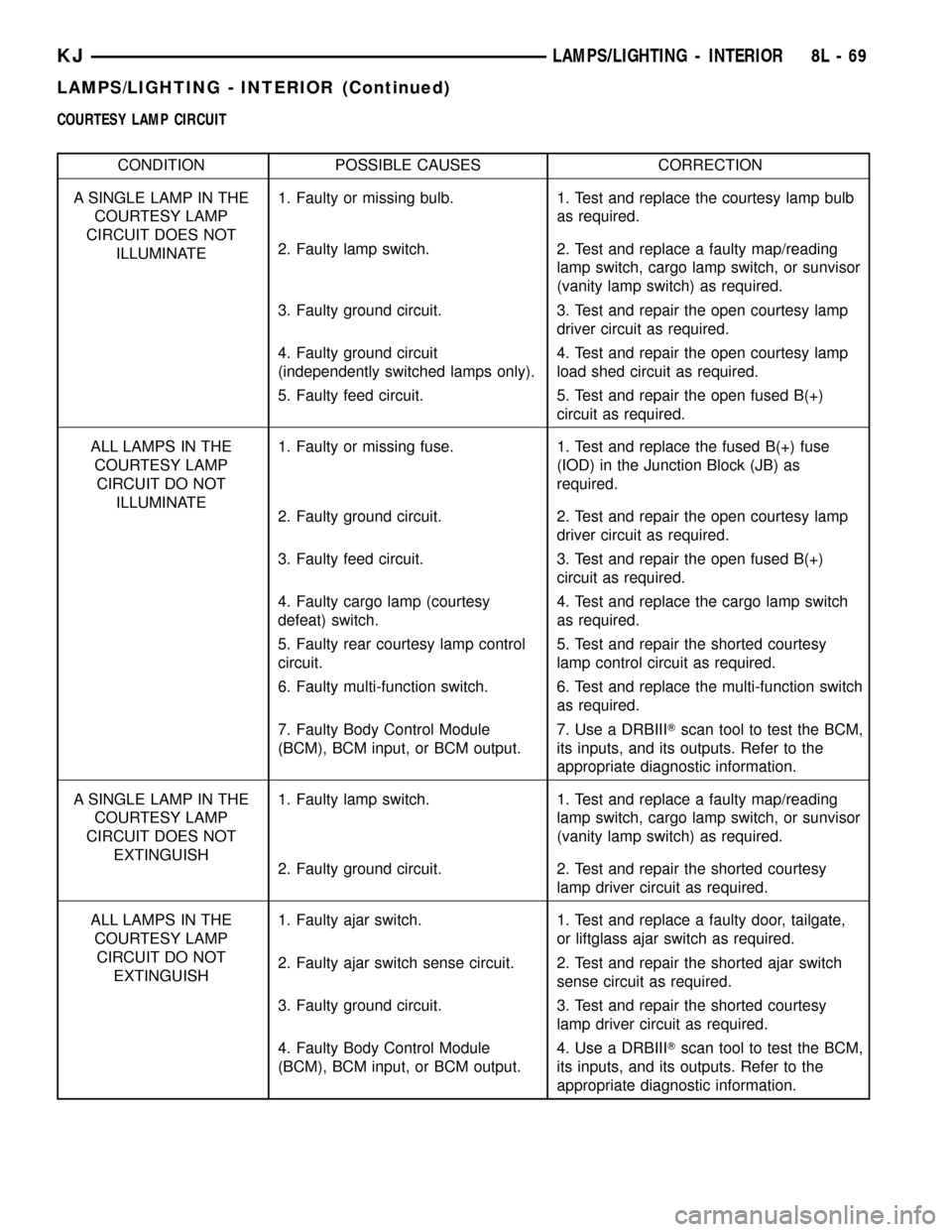tail light JEEP LIBERTY 2002 KJ / 1.G Owner's Guide
[x] Cancel search | Manufacturer: JEEP, Model Year: 2002, Model line: LIBERTY, Model: JEEP LIBERTY 2002 KJ / 1.GPages: 1803, PDF Size: 62.3 MB
Page 496 of 1803

driver side instrument panel end bracket near the
Junction Block (JB).
The park lamp relay can be diagnosed using con-
ventional diagnostic tools and methods.
DIAGNOSIS AND TESTING - PARK LAMP
RELAY
The park lamp relay (Fig. 54) is located in the
Junction Block (JB) under the driver side outboard
end of the instrument panel. Refer to the appropriate
wiring information. The wiring information includes
wiring diagrams, proper wire and connector repair
procedures, details of wire harness routing and
retention, connector pin-out information and location
views for the various wire harness connectors, splices
and grounds.
WARNING: ON VEHICLES EQUIPPED WITH AIR-
BAGS, DISABLE THE SUPPLEMENTAL RESTRAINT
SYSTEM BEFORE ATTEMPTING ANY STEERING
WHEEL, STEERING COLUMN, DRIVER AIRBAG,
PASSENGER AIRBAG, SEAT BELT TENSIONER,
FRONT IMPACT SENSORS, SIDE CURTAIN AIRBAG,
OR INSTRUMENT PANEL COMPONENT DIAGNOSIS
OR SERVICE. DISCONNECT AND ISOLATE THE
BATTERY NEGATIVE (GROUND) CABLE, THEN
WAIT TWO MINUTES FOR THE SYSTEM CAPACI-
TOR TO DISCHARGE BEFORE PERFORMING FUR-
THER DIAGNOSIS OR SERVICE. THIS IS THE ONLY
SURE WAY TO DISABLE THE SUPPLEMENTAL
RESTRAINT SYSTEM. FAILURE TO TAKE THE
PROPER PRECAUTIONS COULD RESULT IN ACCI-
DENTAL AIRBAG DEPLOYMENT AND POSSIBLE
PERSONAL INJURY.
(1) Remove the park lamp relay from the JB.
(Refer to 8 - ELECTRICAL/LAMPS/LIGHTING -
EXTERIOR/PARK LAMP RELAY - REMOVAL).
(2) A relay in the de-energized position should
have continuity between terminals 87A and 30, and
no continuity between terminals 87 and 30. If OK, go
to Step 3. If not OK, replace the faulty relay.
(3) Resistance between terminals 85 and 86 (elec-
tromagnet) should be 75 8 ohms. If OK, go to Step
4. If not OK, replace the faulty relay.
(4) Connect a battery to terminals 85 and 86.
There should now be continuity between terminals
30 and 87, and no continuity between terminals 87A
and 30. If OK, reinstall the relay and use a DRBIIIt
scan tool to perform further testing. Refer to the
appropriate diagnostic information.
REMOVAL
WARNING: ON VEHICLES EQUIPPED WITH AIR-
BAGS, DISABLE THE SUPPLEMENTAL RESTRAINT
SYSTEM BEFORE ATTEMPTING ANY STEERING
WHEEL, STEERING COLUMN, DRIVER AIRBAG,
PASSENGER AIRBAG, SEAT BELT TENSIONER,
FRONT IMPACT SENSORS, SIDE CURTAIN AIRBAG,
OR INSTRUMENT PANEL COMPONENT DIAGNOSIS
OR SERVICE. DISCONNECT AND ISOLATE THE
BATTERY NEGATIVE (GROUND) CABLE, THEN
WAIT TWO MINUTES FOR THE SYSTEM CAPACI-
TOR TO DISCHARGE BEFORE PERFORMING FUR-
THER DIAGNOSIS OR SERVICE. THIS IS THE ONLY
SURE WAY TO DISABLE THE SUPPLEMENTAL
RESTRAINT SYSTEM. FAILURE TO TAKE THE
PROPER PRECAUTIONS COULD RESULT IN ACCI-
DENTAL AIRBAG DEPLOYMENT AND POSSIBLE
PERSONAL INJURY.
(1) Disconnect and isolate the battery negative
cable.
(2) Remove the steering column opening cover
from the instrument panel. (Refer to 23 - BODY/IN-
STRUMENT PANEL/STEERING COLUMN OPEN-
ING COVER - REMOVAL).
(3) Remove the park lamp relay by grasping it
firmly and pulling it straight out from the receptacle
in the Junction Block (JB) (Fig. 55).
Fig. 54 ISO Micro Relay
30 - COMMON FEED
85 - COIL GROUND
86 - COIL BATTERY
87 - NORMALLY OPEN
87A - NORMALLY CLOSED
KJLAMPS/LIGHTING - EXTERIOR 8L - 55
PARK LAMP RELAY (Continued)
Page 498 of 1803

OPERATION
The rear fog lamp relay is an electromechanical
switch that uses a low current input from the Body
Control Module (BCM) to control a high current out-
put to the rear fog lamps. The movable common feed
contact point is held against the fixed normally
closed contact point by spring pressure. When the
relay coil is energized, an electromagnetic field is
produced by the coil windings. This electromagnetic
field draws the movable relay contact point away
from the fixed normally closed contact point, and
holds it against the fixed normally open contact
point. When the relay coil is de-energized, spring
pressure returns the movable contact point back
against the fixed normally closed contact point. A
resistor is connected in parallel with the relay coil in
the relay, and helps to dissipate voltage spikes and
electromagnetic interference that can be generated as
the electromagnetic field of the relay coil collapses.
The rear fog lamp relay terminals are connected to
the vehicle electrical system through a connector
receptacle in the Junction Block (JB). The inputs and
outputs of the rear fog lamp relay include:
²Common Feed Terminal- The common feed
terminal (30) receives battery current at all times
from a fuse in the JB through a fused B(+) circuit.
²Coil Ground Terminal- The coil ground termi-
nal (85) is connected to a control output of the pre-
mium Body Control Module (BCM) through a rear
fog lamp relay control circuit. The BCM controls rear
fog lamp operation by controlling a ground path
through this circuit.
²Coil Battery Terminal- The coil battery ter-
minal (86) receives battery current at all times from
a fuse in the JB through a fused B(+) circuit.
²Normally Open Terminal- The normally open
terminal (87) is connected to the rear fog lamps
through a rear fog lamp relay output circuit and pro-
vides battery current to the rear fog lamps whenever
the relay is energized.
²Normally Closed Terminal- The normally
closed terminal (87A) is not connected in this appli-
cation.
The rear fog lamp relay can be diagnosed using
conventional diagnostic tools and methods.
DIAGNOSIS AND TESTING - REAR FOG LAMP
RELAY
The rear fog lamp relay (Fig. 57) is located in the
Junction Block (JB) under the driver side outboard
end of the instrument panel. Refer to the appropriate
wiring information. The wiring information includes
wiring diagrams, proper wire and connector repair
procedures, details of wire harness routing and
retention, connector pin-out information and locationviews for the various wire harness connectors, splices
and grounds.
WARNING: ON VEHICLES EQUIPPED WITH AIR-
BAGS, DISABLE THE SUPPLEMENTAL RESTRAINT
SYSTEM BEFORE ATTEMPTING ANY STEERING
WHEEL, STEERING COLUMN, DRIVER AIRBAG,
PASSENGER AIRBAG, SEAT BELT TENSIONER,
FRONT IMPACT SENSORS, SIDE CURTAIN AIRBAG,
OR INSTRUMENT PANEL COMPONENT DIAGNOSIS
OR SERVICE. DISCONNECT AND ISOLATE THE
BATTERY NEGATIVE (GROUND) CABLE, THEN
WAIT TWO MINUTES FOR THE SYSTEM CAPACI-
TOR TO DISCHARGE BEFORE PERFORMING FUR-
THER DIAGNOSIS OR SERVICE. THIS IS THE ONLY
SURE WAY TO DISABLE THE SUPPLEMENTAL
RESTRAINT SYSTEM. FAILURE TO TAKE THE
PROPER PRECAUTIONS COULD RESULT IN ACCI-
DENTAL AIRBAG DEPLOYMENT AND POSSIBLE
PERSONAL INJURY.
(1) Remove the rear fog lamp relay from the JB.
(Refer to 8 - ELECTRICAL/LAMPS/LIGHTING -
EXTERIOR/REAR FOG LAMP RELAY - REMOVAL).
(2) A relay in the de-energized position should
have continuity between terminals 87A and 30, and
no continuity between terminals 87 and 30. If OK, go
to Step 3. If not OK, replace the faulty relay.
(3) Resistance between terminals 85 and 86 (elec-
tromagnet) should be 75 8 ohms. If OK, go to Step
4. If not OK, replace the faulty relay.
(4) Connect a battery to terminals 85 and 86.
There should now be continuity between terminals
30 and 87, and no continuity between terminals 87A
Fig. 57 ISO Micro Relay
30 - COMMON FEED
85 - COIL GROUND
86 - COIL BATTERY
87 - NORMALLY OPEN
87A - NORMALLY CLOSED
KJLAMPS/LIGHTING - EXTERIOR 8L - 57
REAR FOG LAMP RELAY (Continued)
Page 500 of 1803

Be certain any removed bulb is replaced with the
same bulb size and type that was removed.
(1) Disconnect and isolate the battery negative
cable.
(2) Remove the rear lamp unit from the end of the
quarter panel. (Refer to 8 - ELECTRICAL/LAMPS/
LIGHTING - EXTERIOR/REAR LAMP UNIT -
REMOVAL).
(3) Firmly grasp the socket on the socket plate at
the back of the rear lamp unit housing for the bulb
that is being removed (Fig. 59).
(4) Rotate the socket on the socket plate at the
back of the rear lamp unit housing counterclockwise
about 30 degrees.
(5) Pull the socket and bulb straight out of the
back of the rear lamp unit housing.
(6) Pull the bulb straight out of the rear lamp unit
socket.
INSTALLATION
CAUTION: Always use the correct bulb size and
type for replacement. An incorrect bulb size or type
may overheat and cause damage to the lamp, the
socket and/or the lamp wiring.
(1) Align the base of the bulb with the receptacle
in the rear lamp unit socket.
(2) Push the bulb straight into the rear lamp unit
socket until it is firmly seated.
(3) Align the socket and bulb with the opening in
the socket plate on the back of the rear lamp unit
housing (Fig. 59).(4) Push the socket and bulb straight into the rear
lamp unit housing until the socket is firmly seated
against the socket plate.
(5) Rotate the socket on the socket plate at the
back of the rear lamp unit housing clockwise about
30 degrees.
(6) Reinstall the rear lamp unit onto the end of the
quarter panel. (Refer to 8 - ELECTRICAL/LAMPS/
LIGHTING - EXTERIOR/REAR LAMP UNIT -
INSTALLATION).
(7) Reconnect the battery negative cable.
REAR LAMP UNIT
REMOVAL
(1) Disconnect and isolate the battery negative
cable.
(2) Open the tailgate to access and remove the two
screws that secure the inboard side of the rear lamp
unit to the side jamb of the tailgate opening (Fig. 60).
(3) Pull the outboard side of the rear lamp unit
rearward (away from the end of the quarter panel)
far enough to unsnap the two ball studs on the out-
board side of the lamp housing from the plastic nuts
in the quarter panel.
(4) Pull the rear lamp unit away from the quarter
panel far enough to access and disconnect the wire
harness connector for the lamp unit from the connec-
tor receptacle on the lamp socket plate.
(5) Remove the rear lamp unit from the quarter
panel.
Fig. 59 Rear Lamp Bulb Remove/Install
1 - REAR LAMP HOUSING
2 - BULB HOLDER
3 - BULB
4 - SOCKET PLATE
Fig. 60 Rear Lamp Unit Remove/Install
1 - PLASTIC NUT (2)
2 - WIRE HARNESS CONNECTOR
3 - PLASTIC NUT (2)
4 - REAR LAMP UNIT
5 - SCREW (2)
KJLAMPS/LIGHTING - EXTERIOR 8L - 59
REAR LAMP BULB (Continued)
Page 501 of 1803

(6) Remove the plastic nuts from the quarter panel
and discard.
INSTALLATION
(1) Install new plastic nuts into the quarter panel
(Fig. 60).
(2) Position the rear lamp unit to the quarter
panel.
(3) Reconnect the wire harness connector for the
rear lamp unit to the connector receptacle on the
lamp socket plate.
(4) Align the two ball studs on the outboard side of
the rear lamp unit housing with the plastic nuts in
the quarter panel.
(5) Using hand pressure, push the outboard side of
the rear lamp unit forward (towards the end of the
quarter panel) far enough to snap the two ball studs
on the outboard side of the lamp housing into the
plastic nuts in the quarter panel.
(6) Align the mounting holes on the inboard side of
the rear lamp unit housing with the plastic nuts in
the side jamb of the tailgate opening.
(7) Install and tighten the two screws that secure
the inboard side of the rear lamp unit housing to the
plastic nuts in the side jamb of the tailgate opening.
Tighten the screws to 2 N´m (20 in. lbs.).
(8) Reconnect the battery negative cable.
REPEATER LAMP BULB
REMOVAL
Side repeater lamps are used only on vehicles man-
ufactured for certain markets where these lamps are
required.
(1) Disconnect and isolate the battery negative
cable.
(2) Remove the repeater lamp unit from the front
fender panel. (Refer to 8 - ELECTRICAL/LAMPS/
LIGHTING - EXTERIOR/REPEATER LAMP UNIT -
REMOVAL).
(3) Rotate the repeater lamp socket in the lamp
lens counterclockwise about 30 degrees (Fig. 61).
(4) Pull the socket and bulb straight out of the
repeater lamp lens.
(5) Pull the bulb straight out of the repeater lamp
socket.
INSTALLATION
Side repeater lamps are used only on vehicles man-
ufactured for certain markets where these lamps are
required.
CAUTION: Always use the correct bulb size and
type for replacement. An incorrect bulb size or typemay overheat and cause damage to the lamp, the
socket and/or the lamp wiring.
(1) Align the base of the bulb with the receptacle
in the repeater lamp socket.
(2) Push the bulb straight into the repeater lamp
socket until it is firmly seated.
(3) Align the socket and bulb with the socket open-
ing in the repeater lamp lens (Fig. 61).
(4) Push the socket and bulb straight into the
repeater lamp lens until it is firmly seated
(5) Rotate the repeater lamp socket in the lamp
lens clockwise about 30 degrees.
(6) Reinstall the repeater lamp unit onto the front
fender panel. (Refer to 8 - ELECTRICAL/LAMPS/
LIGHTING - EXTERIOR/REPEATER LAMP UNIT -
INSTALLATION).
(7) Reconnect the battery negative cable.
REPEATER LAMP UNIT
REMOVAL
Side repeater lamps are used only on vehicles man-
ufactured for certain markets where these lamps are
required.
(1) Disconnect and isolate the battery negative
cable.
(2) Using a trim stick or another suitable wide
flat-bladed tool, carefully pry at the clearance notch
in the lower edge of the repeater lamp lens to disen-
gage the snap features of the lens from the mounting
hole in the front fender panel (Fig. 62).
(3) Pull the repeater lamp unit out from the front
fender panel far enough to access and disconnect the
Fig. 61 Repeater Lamp Bulb Remove/Install
1 - FRONT FENDER
2 - SOCKET
3 - BULB
4 - LENS
8L - 60 LAMPS/LIGHTING - EXTERIORKJ
REAR LAMP UNIT (Continued)
Page 503 of 1803

Relays conforming to the ISO specifications have
common physical dimensions, current capacities, ter-
minal patterns, and terminal functions. The relay is
contained within a small, rectangular, molded plastic
housing and is connected to all of the required inputs
and outputs by five integral male spade-type termi-
nals that extend from the bottom of the relay base.
The trailer tow relays cannot be adjusted or
repaired and, if faulty or damaged, the inoperative
relay must be replaced.
OPERATION
The trailer tow relays are electromechanical
switches. The relays each use an input from the cir-
cuit that they isolate from the trailer wiring to con-
trol a high current output to the trailer. The movable
common feed contact point is held against the fixed
normally closed contact point by spring pressure.
When the relay coil is energized, an electromagnetic
field is produced by the coil windings. This electro-
magnetic field draws the movable relay contact point
away from the fixed normally closed contact point,
and holds it against the fixed normally open contact
point. When the relay coil is de-energized, spring
pressure returns the movable contact point back
against the fixed normally closed contact point. A
resistor is connected in parallel with the relay coil in
the relay, and helps to dissipate voltage spikes and
electromagnetic interference that can be generated as
the electromagnetic field of the relay coil collapses.
The terminals of each trailer tow relay are con-
nected to the vehicle electrical system through a con-nector bank in the rear lighting wire harness above
the right rear wheelhouse. Refer to the appropriate
wiring information. The wiring information includes
wiring diagrams, proper wire and connector repair
procedures, details of wire harness routing and
retention, connector pin-out information and location
views for the various wire harness connectors, splices
and grounds. The trailer tow relays can be diagnosed
using conventional diagnostic tools and methods.
DIAGNOSIS AND TESTING - TRAILER TOW
RELAY
The trailer tow relays (Fig. 65) are located in a
connector bank above the right rear wheelhouse.
Refer to the appropriate wiring information. The wir-
ing information includes wiring diagrams, proper
wire and connector repair procedures, details of wire
harness routing and retention, connector pin-out
information and location views for the various wire
harness connectors, splices and grounds.
WARNING: ON VEHICLES EQUIPPED WITH AIR-
BAGS, DISABLE THE SUPPLEMENTAL RESTRAINT
SYSTEM BEFORE ATTEMPTING ANY STEERING
WHEEL, STEERING COLUMN, DRIVER AIRBAG,
PASSENGER AIRBAG, SEAT BELT TENSIONER,
FRONT IMPACT SENSORS, SIDE CURTAIN AIRBAG,
OR INSTRUMENT PANEL COMPONENT DIAGNOSIS
OR SERVICE. DISCONNECT AND ISOLATE THE
BATTERY NEGATIVE (GROUND) CABLE, THEN
WAIT TWO MINUTES FOR THE SYSTEM CAPACI-
TOR TO DISCHARGE BEFORE PERFORMING FUR-
THER DIAGNOSIS OR SERVICE. THIS IS THE ONLY
SURE WAY TO DISABLE THE SUPPLEMENTAL
RESTRAINT SYSTEM. FAILURE TO TAKE THE
PROPER PRECAUTIONS COULD RESULT IN ACCI-
DENTAL AIRBAG DEPLOYMENT AND POSSIBLE
PERSONAL INJURY.
(1) Remove the trailer tow relay from the connec-
tor bank. (Refer to 8 - ELECTRICAL/LAMPS/LIGHT-
ING - EXTERIOR/TRAILER TOW RELAY -
REMOVAL).
(2) A relay in the de-energized position should
have continuity between terminals 87A and 30, and
no continuity between terminals 87 and 30. If OK, go
to Step 3. If not OK, replace the faulty relay.
(3) Resistance between terminals 85 and 86 (elec-
tromagnet) should be 75 8 ohms. If OK, go to Step
4. If not OK, replace the faulty relay.
(4) Connect a battery to terminals 85 and 86.
There should now be continuity between terminals
30 and 87, and no continuity between terminals 87A
and 30. If OK, test the input and output circuits of
the relay. Refer to the appropriate wiring informa-
tion.
Fig. 64 Trailer Tow Relays
1 - RELAY CONNECTOR BANK
2 - REAR BODY WIRE HARNESS
3 - LEFT TURN RELAY
4 - RIGHT TURN RELAY
5 - BRAKE LAMP RELAY
6 - FUSED IGNITION SWITCH OUTPUT (RUN) RELAY
8L - 62 LAMPS/LIGHTING - EXTERIORKJ
TRAILER TOW RELAY (Continued)
Page 505 of 1803

INSTALLATION
The trailer tow relay bank contains four relays.
The service procedures for each relay are the same.
Be certain any removed relay is replaced with the
same relay size and type that was removed.
WARNING: ON VEHICLES EQUIPPED WITH AIR-
BAGS, DISABLE THE SUPPLEMENTAL RESTRAINT
SYSTEM BEFORE ATTEMPTING ANY STEERING
WHEEL, STEERING COLUMN, DRIVER AIRBAG,
PASSENGER AIRBAG, SEAT BELT TENSIONER,
FRONT IMPACT SENSORS, SIDE CURTAIN AIRBAG,
OR INSTRUMENT PANEL COMPONENT DIAGNOSIS
OR SERVICE. DISCONNECT AND ISOLATE THE
BATTERY NEGATIVE (GROUND) CABLE, THEN
WAIT TWO MINUTES FOR THE SYSTEM CAPACI-
TOR TO DISCHARGE BEFORE PERFORMING FUR-
THER DIAGNOSIS OR SERVICE. THIS IS THE ONLY
SURE WAY TO DISABLE THE SUPPLEMENTAL
RESTRAINT SYSTEM. FAILURE TO TAKE THE
PROPER PRECAUTIONS COULD RESULT IN ACCI-
DENTAL AIRBAG DEPLOYMENT AND POSSIBLE
PERSONAL INJURY.
(1) Position the trailer tow relay to the proper con-
nector in the connector bank (Fig. 67).
(2) Align the trailer tow relay terminals with the
terminal cavities in the connector.
(3) Push firmly and evenly on the top of the trailer
tow relay until the terminals are fully seated in the
terminal cavities in the connector.
(4) Carefully restore the foam wrap around the
trailer tow relay connector bank (Fig. 66).
(5) Reach through the access hole in the quarter
inner panel behind the right rear wheelhouse to
place the trailer tow relay connector bank on the top
of the right rear wheelhouse between the quarter
inner and outer panels.
(6) Reinstall the trim onto the right side quarter
inner panel. (Refer to 23 - BODY/INTERIOR/QUAR-
TER TRIM PANEL - INSTALLATION).
(7) Reconnect the battery negative cable.
TRAILER TOW WIRING
DESCRIPTION
Vehicles equipped with an optional factory-in-
stalled (not dealer-installed or port-installed) trailer
towing package have a rear body wire harness that
includes an integral trailer tow wiring take out that
connects to a heavy duty, sealed, 7-pin trailer tow
connector located on a bracket on the trailer hitch
receiver (Fig. 68). This harness includes a second
take out with a trailer tow relay connector bank and
four trailer tow relays that isolate the right turn sig-
nal, left turn signal, and brake lamp circuits of the
vehicle from the electrical system of the trailer. The
fourth relay in the connector bank provides a fused
ignition switch output (run) source of battery current
to the trailer tow connector through a trailer tow
relay output circuit. The package also includes an
adapter harness (stored beneath the left rear seat
cushion of the vehicle when it is shipped from the
factory) that adapts the 7-pin trailer tow connector to
a standard, light-duty, 4-pin trailer tow connector.
Refer to the appropriate wiring information. The wir-
ing information includes wiring diagrams, proper
wire and connector repair procedures, further details
on wire harness routing and retention, as well as
pin-out and location views for the various wire har-
ness connectors, splices and grounds.
Fig. 68 Trailer Tow Wiring
1 - RETAINER CLIP (4)
2 - REAR BODY HARNESS (TRAILER TOW TAKE OUT)
3 - RETAINER CLIP (2)
4 - WIRE HARNESS CONNECTOR
8L - 64 LAMPS/LIGHTING - EXTERIORKJ
TRAILER TOW RELAY (Continued)
Page 506 of 1803

LAMPS/LIGHTING - INTERIOR
TABLE OF CONTENTS
page page
LAMPS/LIGHTING - INTERIOR
DESCRIPTION.........................65
OPERATION...........................67
DIAGNOSIS AND TESTING - LAMPS/
LIGHTING - INTERIOR..................68
SPECIFICATIONS - LAMPS/LIGHTING -
INTERIOR...........................71
ASH RECEIVER LAMP BULB
REMOVAL.............................71
INSTALLATION.........................71
ASH RECEIVER LAMP UNIT
REMOVAL.............................72
INSTALLATION.........................72
CARGO LAMP BULB
REMOVAL.............................72
INSTALLATION.........................73
CARGO LAMP SWITCH
REMOVAL.............................73
INSTALLATION.........................74
CARGO LAMP UNIT
REMOVAL.............................74
INSTALLATION.........................74
COMPASS MINI-TRIP ILLUMINATION BULB
REMOVAL.............................74
INSTALLATION.........................75
COURTESY LAMP BULB
REMOVAL.............................75
INSTALLATION.........................76
COURTESY LAMP UNIT
REMOVAL.............................76INSTALLATION.........................77
DOOR AJAR SWITCH
DESCRIPTION.........................77
OPERATION...........................77
FLIP-UP GLASS AJAR SWITCH
DESCRIPTION.........................77
OPERATION...........................77
HEATER-A/C CONTROL ILLUMINATION BULB
REMOVAL.............................78
INSTALLATION.........................78
READING LAMP BULB
REMOVAL.............................79
INSTALLATION.........................79
READING LAMP SWITCH
REMOVAL.............................80
INSTALLATION.........................80
READING LAMP UNIT
REMOVAL.............................81
INSTALLATION.........................81
TAILGATE AJAR SWITCH
DESCRIPTION.........................82
OPERATION...........................82
TRANSMISSION RANGE INDICATOR
ILLUMINATION BULB
REMOVAL.............................82
INSTALLATION.........................83
VANITY LAMP BULB
REMOVAL.............................83
INSTALLATION.........................84
LAMPS/LIGHTING - INTERIOR
DESCRIPTION
The interior lighting system (Fig. 1) for this model
includes the following incandescent interior lamps:
²Ash Receiver Lamp- An available ash receiver
lamp is located above the ash receiver housing
behind the instrument panel center bezel, and is con-
trolled by the panel lamps dimmer circuit.
²Cargo Lamp- An available cargo lamp with an
integral lens-actuated courtesy disable switch is
located in the headliner near the rear roof header,
and is controlled by the courtesy lamp circuit.
²Courtesy Lamps- Available courtesy lamps are
located below both the right and left side of the
instrument panel, and are controlled by the courtesy
lamp circuit.²Compass Mini-Trip Control Illumination
Lamps- The optional Compass Mini-Trip Computer
(CMTC) has three replaceable control illumination
bulb/bulb holder units on its circuit board that are
controlled by the panel lamps dimmer circuit.
²Dome Lamp- A standard front dome lamp that
does not include an on-off switch is located in the
headliner near the windshield header, and is con-
trolled by the courtesy lamp circuit.
²Hazard Switch Illumination/Indicator
Lamp- The hazard switch control button has a non-
replaceable illumination/indicator bulb soldered onto
its circuit board that is controlled by both the hazard
switch circuitry and the panel lamps dimmer circuit.
(Refer to 8 - ELECTRICAL/LAMPS/LIGHTING -
EXTERIOR/HAZARD SWITCH - DESCRIPTION).
²Heater-Air Conditioner Control Illumina-
tion Lamps- The heater-air conditioner control has
KJLAMPS/LIGHTING - INTERIOR 8L - 65
Page 508 of 1803

mission have an illuminated transmission range indi-
cator integral to the console mounted gearshift
mechanism, and controlled by the panel lamps dim-
mer circuit.
²Vanity Lamps- Available single intensity van-
ity lamps are located on each side of a covered mirror
on both the right and left sun visors, and are con-
trolled by an integral vanity mirror cover-actuated
switch on the courtesy lamp circuit.
Other components of the interior lighting system
for this model include:
²Body Control Module- The Body Control
Module (BCM) is located on the Junction Block (JB)
under the driver side outboard end of the instrument
panel. (Refer to 8 - ELECTRICAL/ELECTRONIC
CONTROL MODULES/BODY CONTROL MODULE
- DESCRIPTION).
²Door Ajar Switches- A door ajar switch is
integral to the door latch mechanism of each front
and rear door.
²Flip-Up Glass Ajar Switch- A flip-up glass
ajar switch is integral to the flip-up glass latch mech-
anism on the top of the tailgate inner panel.
²Multi-Function Switch- The multi-function
switch is located on the top of the steering column,
just below the steering wheel. The multi-function
switch includes a left (lighting) control stalk and a
right (wiper) control stalk. The left control stalk is
dedicated to providing almost all of the driver con-
trols for both the exterior and interior lighting sys-
tems. (Refer to 8 - ELECTRICAL/LAMPS/LIGHTING
- EXTERIOR/MULTI-FUNCTION SWITCH -
DESCRIPTION).
²Tailgate Ajar Switch- A tailgate ajar switch is
integral to the latch mechanism of the tailgate.
Hard wired circuitry connects the interior lighting
system components to the electrical system of the
vehicle. These hard wired circuits are integral to sev-
eral wire harnesses, which are routed throughout the
vehicle and retained by many different methods.
These circuits may be connected to each other, to the
vehicle electrical system and to the interior lighting
system components through the use of a combination
of soldered splices, splice block connectors, and many
different types of wire harness terminal connectors
and insulators. Refer to the appropriate wiring infor-
mation. The wiring information includes wiring dia-
grams, proper wire and connector repair procedures,
further details on wire harness routing and reten-
tion, as well as pin-out and location views for the
various wire harness connectors, splices and grounds.
OPERATION
The interior lighting systems can be divided into
two general classifications based upon the circuit
that controls their operation: The courtesy lamp cir-cuit, or the panel lamps dimmer circuit. Following
are paragraphs that briefly describe the operation of
each of the major interior lighting systems. The hard
wired circuits and components of the interior lighting
systems may be diagnosed and tested using conven-
tional diagnostic tools and procedures. However, con-
ventional diagnostic methods may not prove
conclusive in the diagnosis of the Body Control Mod-
ule (BCM), the ElectroMechanical Instrument Clus-
ter (EMIC), or the Programmable Communications
Interface (PCI) data bus network. The most reliable,
efficient, and accurate means to diagnose the BCM,
the EMIC, and the PCI data bus network inputs and
outputs related to the various interior lighting sys-
tems requires the use of a DRBIIItscan tool. Refer
to the appropriate diagnostic information.
COURTESY LAMP CIRCUIT Depending upon the
selected vehicle options the courtesy lamp circuit
may include the courtesy lamps located below the
instrument panel, the dome or map/reading lamps
located in the headliner near the windshield, the
cargo lamp located in the headliner near the rear
roof header, and the vanity lamps located in the sun
visors. The lamps in the courtesy lamp circuit are
provided with battery current at all times from a
fused B(+) fuse in the Junction Block (JB) through a
fused B(+) circuit. The Body Control Module (BCM)
controls the ground path for these lamps using an
internal driver through the courtesy lamp driver cir-
cuit based upon hard wired inputs from the door ajar
switches, the flip-up glass ajar switch, and the tail-
gate ajar switch. After all of the ajar switch inputs to
the BCM transition to open, the BCM will keep the
lamps illuminated for about 27 seconds, then fade
the lamps to off (theater dimming) over about three
seconds.
The BCM also provides courtesy lamp operation
based upon a resistor multiplexed input from the
interior lighting control ring on the left (lighting)
control stalk of the multi-function switch through the
headlamp switch mux circuit, and in response to cer-
tain inputs from the optional Remote Keyless Entry
(RKE) system. A resistor multiplexed courtesy lamp
defeat input from the control ring on the left (light-
ing) control stalk of the multi-function switch will
cause the BCM to override normal courtesy lamp
operation based upon inputs from all of the ajar
switches. A hard wired input from the courtesy lamp
defeat switch in the optional cargo lamp through a
rear courtesy lamp control circuit will cause the BCM
to override normal courtesy lamp operation based
upon inputs from only the flip-up glass and tailgate
ajar switches.
For those lamps on the courtesy lamp circuit with
independent switching, such as the optional reading
lamps and vanity lamps, the BCM provides a ground
KJLAMPS/LIGHTING - INTERIOR 8L - 67
LAMPS/LIGHTING - INTERIOR (Continued)
Page 509 of 1803

path to the switches using another internal driver
through the courtesy lamp load shed circuit. The
BCM provides a battery saver (load shedding) feature
for all courtesy lamps, which will automatically turn
these lamps off if they are left on for more than
about eight minutes with the ignition switch in the
Off position.
PANEL LAMPS DIMMER CIRCUIT The panel
lamps dimmer circuit includes the ElectroMechanical
Instrument Cluster (EMIC), heater-air conditioner
control, hazard switch and, depending upon the
selected vehicle options, ash receiver, and automatic
transmission range indicator illumination lamps. All
lamps in the panel lamps dimmer circuit are pro-
vided a path to ground at all times through a hard
wired ground circuit. These lamps illuminate based
upon inputs to the Body Control Module (BCM) from
the exterior lighting control knob and the interior
lighting control ring on the left (lighting) control
stalk of the multi-function switch. The control knob
on the left control stalk of the multi-function switch
selects the exterior lights, while the control ring
selects the panel lamps intensity (dimming) level.
When the exterior lighting is turned On, the BCM
energizes the park lamp relay and provides an elec-
tronic dimming level message to the ElectroMechani-
cal Instrument Cluster (EMIC), the radio, and the
Compass Mini-Trip Computer (CMTC) over the Pro-
grammable Communications Interface (PCI) data
bus. The energized park lamp relay provides a hard
wired battery current signal input to the EMIC on
the park lamp relay output circuit. The EMIC
responds to these inputs by supplying a 12-volt Pulse
Width Modulated (PWM) output to all of the incan-
descent lamps in the panel lamps dimmer circuit
over the fused panel lamps dimmer switch signal cir-
cuit. This shared PWM output synchronizes the
selected illumination intensity level of all of the
incandescent lamps in the panel lamps dimmer cir-
cuit.
The EMIC and the radio each use the electronic
dimming level message from the BCM to control and
synchronize the illumination intensity of their own
Vacuum Fluorescent Display (VFD), while the CMTC
uses the dimming level message to control the illumi-
nation intensity of both its VFD and its incandescent
lighting. In addition, when the control ring on the
left (lighting) control stalk of the multi-function
switch is moved to the Parade Mode detent position,
all of the VFDs are illuminated at their full intensity
levels for increased visibility when the vehicle is
driven during daylight hours with the exterior lights
turned On.DIAGNOSIS AND TESTING - LAMPS/LIGHTING
- INTERIOR
The hard wired circuits and components of the
interior lighting system may be diagnosed and tested
using conventional diagnostic tools and procedures.
However, conventional diagnostic methods may not
prove conclusive in the diagnosis of the Body Control
Module (BCM), the ElectroMechanical Instrument
Cluster (EMIC), or the Programmable Communica-
tions Interface (PCI) data bus network. The most
reliable, efficient, and accurate means to diagnose
the BCM, the EMIC, and the PCI data bus network
inputs and outputs related to the various interior
lighting systems requires the use of a DRBIIItscan
tool. Refer to the appropriate diagnostic information.
When diagnosing the interior lighting circuits,
remember that high generator output can burn out
bulbs rapidly and repeatedly; and, that dim or flick-
ering bulbs can be caused by low generator output or
poor battery condition. If one of these symptoms is a
problem on the vehicle being diagnosed, be certain to
diagnose and repair the battery and charging system
as required. Also keep in mind that a good ground is
necessary for proper lighting operation. If a lighting
problem is being diagnosed that involves multiple
symptoms, systems, or components the problem can
often be traced to a loose, corroded, or open ground.
For complete circuit diagrams, refer to the appropri-
ate wiring information. The wiring information
includes wiring diagrams, proper wire and connector
repair procedures, details of wire harness routing
and retention, connector pin-out information and
location views for the various wire harness connec-
tors, splices and grounds.
WARNING: ON VEHICLES EQUIPPED WITH AIR-
BAGS, DISABLE THE SUPPLEMENTAL RESTRAINT
SYSTEM BEFORE ATTEMPTING ANY STEERING
WHEEL, STEERING COLUMN, DRIVER AIRBAG,
PASSENGER AIRBAG, SEAT BELT TENSIONER,
FRONT IMPACT SENSORS, SIDE CURTAIN AIRBAG,
OR INSTRUMENT PANEL COMPONENT DIAGNOSIS
OR SERVICE. DISCONNECT AND ISOLATE THE
BATTERY NEGATIVE (GROUND) CABLE, THEN
WAIT TWO MINUTES FOR THE SYSTEM CAPACI-
TOR TO DISCHARGE BEFORE PERFORMING FUR-
THER DIAGNOSIS OR SERVICE. THIS IS THE ONLY
SURE WAY TO DISABLE THE SUPPLEMENTAL
RESTRAINT SYSTEM. FAILURE TO TAKE THE
PROPER PRECAUTIONS COULD RESULT IN ACCI-
DENTAL AIRBAG DEPLOYMENT AND POSSIBLE
PERSONAL INJURY.
8L - 68 LAMPS/LIGHTING - INTERIORKJ
LAMPS/LIGHTING - INTERIOR (Continued)
Page 510 of 1803

COURTESY LAMP CIRCUIT
CONDITION POSSIBLE CAUSES CORRECTION
A SINGLE LAMP IN THE
COURTESY LAMP
CIRCUIT DOES NOT
ILLUMINATE1. Faulty or missing bulb. 1. Test and replace the courtesy lamp bulb
as required.
2. Faulty lamp switch. 2. Test and replace a faulty map/reading
lamp switch, cargo lamp switch, or sunvisor
(vanity lamp switch) as required.
3. Faulty ground circuit. 3. Test and repair the open courtesy lamp
driver circuit as required.
4. Faulty ground circuit
(independently switched lamps only).4. Test and repair the open courtesy lamp
load shed circuit as required.
5. Faulty feed circuit. 5. Test and repair the open fused B(+)
circuit as required.
ALL LAMPS IN THE
COURTESY LAMP
CIRCUIT DO NOT
ILLUMINATE1. Faulty or missing fuse. 1. Test and replace the fused B(+) fuse
(IOD) in the Junction Block (JB) as
required.
2. Faulty ground circuit. 2. Test and repair the open courtesy lamp
driver circuit as required.
3. Faulty feed circuit. 3. Test and repair the open fused B(+)
circuit as required.
4. Faulty cargo lamp (courtesy
defeat) switch.4. Test and replace the cargo lamp switch
as required.
5. Faulty rear courtesy lamp control
circuit.5. Test and repair the shorted courtesy
lamp control circuit as required.
6. Faulty multi-function switch. 6. Test and replace the multi-function switch
as required.
7. Faulty Body Control Module
(BCM), BCM input, or BCM output.7. Use a DRBIIITscan tool to test the BCM,
its inputs, and its outputs. Refer to the
appropriate diagnostic information.
A SINGLE LAMP IN THE
COURTESY LAMP
CIRCUIT DOES NOT
EXTINGUISH1. Faulty lamp switch. 1. Test and replace a faulty map/reading
lamp switch, cargo lamp switch, or sunvisor
(vanity lamp switch) as required.
2. Faulty ground circuit. 2. Test and repair the shorted courtesy
lamp driver circuit as required.
ALL LAMPS IN THE
COURTESY LAMP
CIRCUIT DO NOT
EXTINGUISH1. Faulty ajar switch. 1. Test and replace a faulty door, tailgate,
or liftglass ajar switch as required.
2. Faulty ajar switch sense circuit. 2. Test and repair the shorted ajar switch
sense circuit as required.
3. Faulty ground circuit. 3. Test and repair the shorted courtesy
lamp driver circuit as required.
4. Faulty Body Control Module
(BCM), BCM input, or BCM output.4. Use a DRBIIITscan tool to test the BCM,
its inputs, and its outputs. Refer to the
appropriate diagnostic information.
KJLAMPS/LIGHTING - INTERIOR 8L - 69
LAMPS/LIGHTING - INTERIOR (Continued)